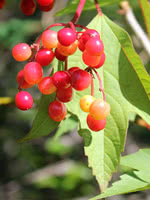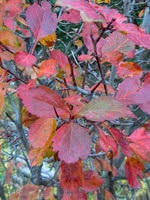Mon-Fri 9am - 5pm Mountain time
Highbush Cranberry vs Black Hawthorn
Viburnum opulus var. americanum (trilobum)
Crataegus douglasii
NOT AVAILABLE THIS SEASON - MIGHT RETURN
Highbush Cranberry produces attractive white flowers in late June and bears edible fruit that matures to a bright red colour in the late summer.
This shrub, native to much of Canada, is fast growing, and its fruit can be eaten raw or cooked into a sauce.
Black Hawthorn is a versatile plant that is native to wetlands and other areas with moist soils, but can also tolerate dry soils. This plant can be grown as a short shrub, or a tree reaching 30 feet tall.
Black Hawthorn is valued for erosion control and attracting pollinators. It also makes an attractive flowering ornamental that can be planted as a specimen or pruned as a hedge. It is commonly used in shelterbelts.
Highbush Cranberry Quick Facts
Black Hawthorn Quick Facts
In row spacing: 0.6 m (2.0 ft)

